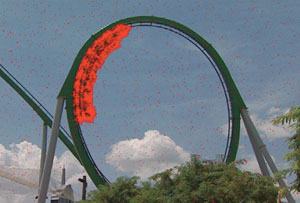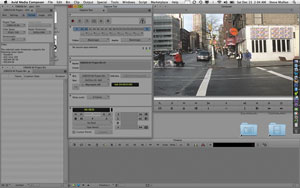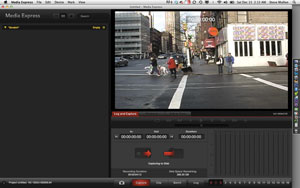Blackmagic Teranex 2D: Field tests of a format converter
Because of the many crossconversion capabilities of the VC100 from Teranex, I have long wanted one. My most critical need was the high-quality conversion of hours of analog and digital tapes going back as far as the early 1980s to pillarbox HD. Unfortunately, the Teranex VC100 cost $90,000. Even after Blackmagic bought the VC100 and began reselling it, despite a huge price drop to only $20,000, it remained an expensive tool.
At the 2012 NAB Show, Blackmagic announced a redesigned VC100 using modern chips. The new price tag — only $1995 for the standard model, called the 2D. (A 3-D version sells for $3995.) The 2D unit offers all conversions in 4:2:2 sampling for a single channel.

Figure 1. The rear of the Teranex 2D features HDMI I/O and a Thunderbolt port.
Both models are small rack-mount units and feature HDMI I/O, analog composite and component I/O (unfortunately, no Y/C input for legacy camcorders and decks), 3Gb/s HD-SDI in and out; eight independent AES/EBU audio I/O connections; stereo analog input/output; and a Thunderbolt port, as shown in Figure 1.
These Blackmagic models still feature high-quality Teranex processing, including format (NTSC/PAL) conversion, HD standards (720/1080) conversion, and SD-to-HD and HD-to-SD crossconversion. The latter two functions include aspect-ratio conversion (pillarbox and letterbox)and smart aspect (variable scaling to stretch 4:3 to 16:9 with minimum distortion). The 2D and 3D provide additional functions such as noise reduction and test signals, plus cadence detect and remove.
The key to Teranex quality is that it can process video in both spatial and temporal domains. This is exemplified by how the unit deinterlaces incoming video to progressive video. The converter implements a moving window of four fields (two frames) to determine which pixels are in motion and which are not. Static pixels — those showing no motion across fields — are moved from the current frame into a “progressive” output frame.

Figure 2. Teranex 2D’s display mode presents moving pixels as red pixels.
The professional video industry's #1 source for news, trends and product and tech information. Sign up below.
Pixels in motion are treated differently. (You can enable a display mode in which the unit presents pixels in motion as red pixels, as shown in Figure 2.)
Moving pixels in the upper field of the current frame are moved into the upper field of the output frame—where they take their place along with the static pixels.
Pixels in motion carried within the current frame’s lower field are rejected. New lower field pixels are interpolated using spatially close lines (from a nearest lower field) above and below the rejected lines. Combing on motion is prevented — although some vertical resolution is lost when the moving lower field pixels are discarded.
Field tests
The first test I performed used the Teranex 2D in stand-alone mode. I fed it an NTSC analog component signal from a Beta SP VTR. I selected the input type by pressing the Component button. The video output mode was set to 1080i60, and the aspect ratio was set to pillarbox to eliminate image distortion. Because all outputs (composite, component analog, HD-SDI and HDMI) are simultaneously active, I only needed to connect an HD recorder to the HD-SDI output connector. An HD monitor was connected via an HDMI cable.

Figure 3. Shown here is Media Composer’s capture window during ingest HD from an SD camcorder. Blackmagic supplies capture drivers for a number of editors, but no driver is available for FCP X.
For the second test, I used the unit as a capture device for several NLEs, feeding it a composite signal from a miniDV camcorder. I selected the input type by pressing the Composite button, and set the video output mode to 1080i60. I set the HD aspect ratio to “Smart,” thereby creating 16:9 video. Stereo audio was fed into the RCA jacks.
Blackmagic supplies capture drivers for Adobe Premiere Pro CS6, Photoshop CS6 and After Effects CS6; Avid Media Composer 6; Apple FCP 7; and DaVinci Resolve. Once the unit is set for the desired input and type of conversion (if any), video and audio are sent via a Thunderbolt cable to the user’s computer. Figure 3 shows the Media Composer’s capture window during ingest of HD from an SD camcorder. Capture media type is set from within their NLE. (The device supports both RS-422 control and batch capture.)
Unfortunately, no capture driver is available for FCP X. The workaround is to capture using Blackmagic’s Media Express application, as shown in Figure 4. (Again, the device supports both RS-422 control and batch capture.) The captured files are then imported into FCP X. Naturally, a capture can be monitored using an HD monitor connected by HDMI.

Figure 4. The workaround for the unavailability of a driver for FCP X is to capture using Blackmagic’s Media Express application, and then import the captured files into FCP X.
For the third test, I used the converter as an output device. Here the software situation was slightly different. Blackmagic supplies a driver that allows viewing the FCP X monitor window. However, for recording from FCP X, one must export a ProRes 422HQ file, import it into Media Express, and then play the file via the Thunderbolt cable to the converter.
For other supported applications, the included drivers enable direct export to the converter. No matter the export method, all output ports are active, with the signal type determined by the buttons that control its conversion operations. Therefore, during export, format (NTSC/PAL) conversion, HD standards (720/1080) conversion, SD-to-HD crossconversion, and HD-to-SD crossconversion are possible.
Unfortunately, the one conversion I needed most was not available. You cannot, using Media Express, play an SD file through the Teranex and capture it as an HD file. You must record the exported file and play it back for capture. For those of us who are in an “all files on hard disk” environment, this is an obvious downside.
However, despite this, the Teranex 2D performed flawlessly in all tests, as did the bundled Blackmagic UltraScope and Blackmagic Disk Speed Test.
—Steve Mullen is the owner of DVC. He can be reached via his website at http://home.mindspring.com/~d-v-c.
